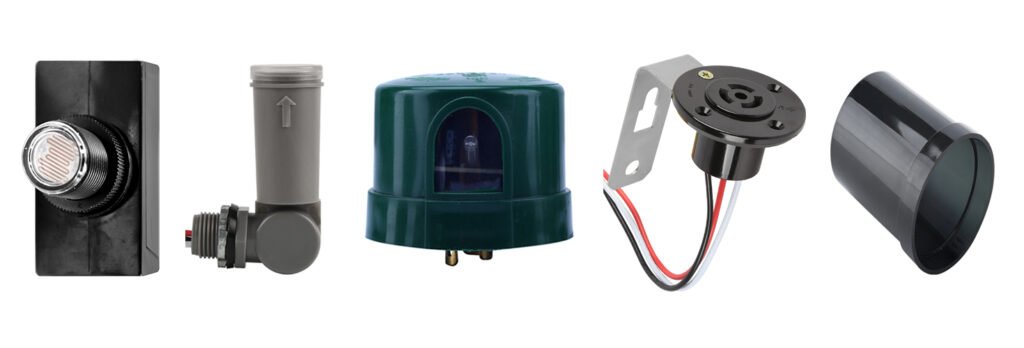Introduction: In the era of modern technology, lighting systems have evolved beyond simple illumination. The photocell, as a key technology, is revolutionizing our perception of lighting with its unique intelligent features. This article delves into the definition, working principles, application areas, and future impact of photocells.
Definition : A photocell is a lighting switch that automatically controls lighting devices by sensing changes in ambient light. It regulates the switching of lamps (automatically turning them on in the evening and off in the morning), adjusts brightness (e.g., lowering brightness after midnight when demand for light is reduced), and manages the timing of light switches (can be pre-set for any desired on/off times). Its principle lies in intelligently adjusting the lighting level based on varying light conditions to enhance the efficiency and energy utilization of lighting systems.
Working Principles :A photocell or photoresistor is a sensor that changes its resistance in response to incident light. The resistance changes according to the light intensity. It decreases as the light intensity increases and the light turns off. It increases as the light intensity decreases and the light turns on.
Application Areas : The photocell finds wide-ranging applications, particularly excelling in outdoor lighting scenarios.
Streetlights: Widely employed in urban road and street lighting systems, photocells automatically activate streetlights at dusk, ensuring safe illumination.

Garden Lights: Utilized for outdoor garden lights, photocells automatically illuminate them during dusk or nighttime, providing appropriate illumination for gardens or courtyards.

Security Lighting: In security lighting, photocells are commonly used to trigger luminaires, enhancing visibility in surrounding areas and contributing to property protection and crime reduction.
Commercial Billboards: Commercial billboards often require illumination at night, and photocells ensure they are automatically lit after dark, enhancing advertising effectiveness.

Outdoor Landscape Lighting: Photocells control outdoor landscape lighting in locations like parks and squares, ensuring luminaires are activated when needed.

Building Facade Lighting: For building facade lighting, photocells adjust light intensity and color temperature based on changing daylight conditions, achieving aesthetics and energy efficiency.

Types :
Categorized based on standards: NEMA and Zhaga Photocell
Categorized based on Functionality:day-night sensor, microwave sensor, dimming sensor
Categorized based on shapes:wire-in photocells, twist-lock photocells, lamp-holder photocells

Categorized based on the number of wires :3-wire, 4-wire, 5-wire, 7-wire & photocell
Advantages:
Photocells offer clear advantages in energy conservation and environmental protection. By implementing automated control, they can adjust lighting intensity according to actual light needs, reducing unnecessary energy consumption. Additionally, the application of photocells supports the intelligent development of lighting systems.
Installation:
Installing photocells is not a complex task, but it requires following specific steps. Before starting any wiring project, ensure the power is off, use insulated tools, and wear appropriate protective gear. Understanding the color coding of wires is crucial to avoid incorrect wiring. After installation, use a multimeter to verify connections and test the functionality of the photocell under different lighting conditions to ensure the connected lighting devices respond appropriately.
Test:
Simulate Day-Night Variations: During testing, simulate changes in light conditions, including transitions between day and night. This can be achieved by adjusting the brightness of the light source or using simulators.
Consider Different Light Sources: The testing should cover various types of light sources, such as natural light, indoor lighting, and other outdoor light sources, to ensure the light-sensitive controller can adapt to diverse environments.
When testing the light-sensitive controller, it is essential not to conduct tests outdoors in direct sunlight or in an indoor environment with artificial lighting during the daytime. Testing under such conditions does not allow for a genuine simulation of the natural day-night light variations and may lead to confusion in the controller’s on/off switching.
Precautions:
The light sensor head cannot be directly exposed to light sources such as car lights, street lights or sunlight for a long time. Such exposure may disrupt the normal operation of the controller. “Test thoroughly before installation and be aware of environmental factors” and adhering to these precautions can maximize the efficiency and longevity of your outdoor lighting system, ensuring consistent performance in varying conditions
Conclusion: As a pioneering technology in the field of lighting, photocells not only enhance the efficiency and energy utilization of lighting systems but also lay the foundation for the development of intelligent lighting. Through continuous innovation and application, photocells will continue to lead lighting systems towards a more intelligent and environmentally friendly future.







